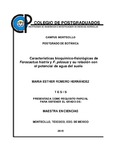| dc.description.abstract | Las plantas de la familia Cactaceae tienen características morfológicas y fisiológicas, como tallos suculentos, espinas, que les permiten reducir la transpiración y son auxiliares en la economía de agua, y el metabolismo ácido del tipo de las Crasuláceas (MAC), que les han permitido adaptarse a ambientes áridos. Ferocactus histrix es una cactácea globosa y F. pilosus tiene el tallo columnar, ambas especies se encuentran en la norma NOM-059-SEMARNAT 2010, en la categoría de riesgo “Sujetas a protección especial”. El objetivo de este estudio fue evaluar características bioquímicas-fisiológicas de las plantas de 10 años de edad de ambas especies, cultivadas en invernadero, y sus modificaciones en dependencia del A del suelo por 1 año. Ya que las cactáceas son resistentes a ciertas condiciones ambientales extremas, como humedad restringida en el suelo, la hipótesis fue que las plantas de F. histrix y F. pilosus mantienen su morfo-fisiología estable durante los meses con humedad edáfica restringida. Plantas de ambas especies se mantuvieron en condiciones de invernadero con y sin riego semanal; después de 3, 6 y 12 meses se evaluaron 19 características, morfológicas en la planta (altura, diámetro, número de costillas, número de areolas por costilla y totales, número de espinas por areola y totales, longitud de una espina central, peso total de las espinas, profundidad de las costillas) y fisiológicas (biomasa seca, mucílago, pectinas, hemicelulosas débilmente y fuertemente unidas, celulosa, ácido málico, potencial de agua (A) y potencial osmótico (π) en el clorénquima y el parénquima. El diseño experimental fue completamente al azar con una planta como unidad experimental y seis repeticiones por muestreo y los tratamientos resultaron de la combinación de la especie y la condición de humedad del suelo. El A de los tejidos con riego de F. histrix fue -1.51 y -1.55 MPa y en F. pilosus fue -1.93 MPa en ambos tejidos. En general, las características morfológicas de ambas especies fueron homogéneas durante el primer año de desarrollo en condiciones de invernadero. Ambas especies después de la suspensión temporal del riego y su reanudación mostraron incremento significativo (P < 0.001) en todas las características morfológicas. El A del clorénquima y del parénquima de F. histrix sin riego disminuyó a -3.23 y -4.61 MPa (P < 0.001 y P = 0.03). En F. pilosus el A del clorénquima y del parénquima disminuyó hasta -9.29 y -4.38 MPa. El porcentaje de ácido málico a los doce meses con riego mostró disminución significativa (P ≤ 0.05) en comparación con las plantas con riego a los tres y seis meses del inicio del estudio. El contenido de los cinco polisacáridos estructurales disminuyó por influencia de la disminución del A del suelo, tanto en el clorénquima como en el parénquima en ambas especies. Las plantas de F. histrix y F. pilosus permanecen vivas y mantienen su fisiología estable durante intervalos relativamente prolongados, de varios meses, con humedad edáfica restringida. _______________ BIOCHEMICAL AND PHYSIOLOGICAL CHARACTERISTICS OF Ferocactus histrix AND F. pilosus AND ITS RELATIONSHIP WITH SOIL WATER POTENTIAL. ABSTRACT: Plants of the Cactaceae family have succulent stems and thorns, which allow them to reduce transpiration and as a consequence, it helps to water use efficiency. In addition, the acid metabolism of the Crassulaceae (MAC) has allowed this plants to adapt to arid environments. Ferocactus histrix is a barrel cactus-type and F. pilosus is a columnar one, both species are "subject to special protection" in the category of risk. The objective of this study was to assess morphological and physiological characteristics of 10 years old plants growth without watering for one year in a greenhouse. Cacti are resistant to soil moisture restriction and the hypothesis was that F. histrix and F. pilosus plants maintain stable their morphological and physiological characteristics growing with restricted soil moisture during one year. Plants of both species were grown with and without weekly irrigation; after 3, 6 and 12 months. There were measured 19 morphological characteristics in the cacti plants (height, diameter, number of ribs per stem, number of areoles by ribs, total number of thorns per areole and total per plant, length of the central thorn, thorns total weight, ribs depth). Also, there were asses nine physiological characteristics in chlorenchyma and the parenchyma (dry biomass, mucilage, pectins, weakly and loosely bound hemicelluloses, cellulose, malic acid, water potential (Ψw) and osmotic potential (Ψπ). The experimental design was completely random, with a plant as experimental unit, and six replications per sampling and treatments resulted from the combination of the species and soil moisture condition. The Ψw of the tissues of F. histrix with irrigation was -1.51 and -1.55 MPa and in F. pilosus was -1.93 MPa in both tissues. The morphological characteristics of both species were generally homogeneous during the first year of development in greenhouse conditions. Both species after the temporary suspension of irrigation and its recovery showed significant increase (P < 0.001) in all morphological characteristics. The ΨW of the chlorenchyma and parenchyma of F. histrix without irrigation decreased to -3.23 and - 4.61 MPa (p < 0.001 and p = 0.03). In F. pilosus the ΨW of the chlorenchyma and parenchyma decreased to -9.29 and -4.38 MPa. The percentage of malic acid after twelve months with irrigation showed significant decrease (P ≤ 0.05) compared with plants with irrigation at three and six months after starting the study. The CAM-idling arose in both species; in F. pilosus was detected at 3 months without irrigation, and in F. histrix after 6 months without irrigation. The five structural polysaccharides content decreased by influence of the soil ΨW, in chlorenchyma and parenchyma of both species. Plants of F. histrix and F. pilosus remain alive and maintain their stable physiology during relatively long intervals, for several months, with restricted soil moisture. | es_MX |

